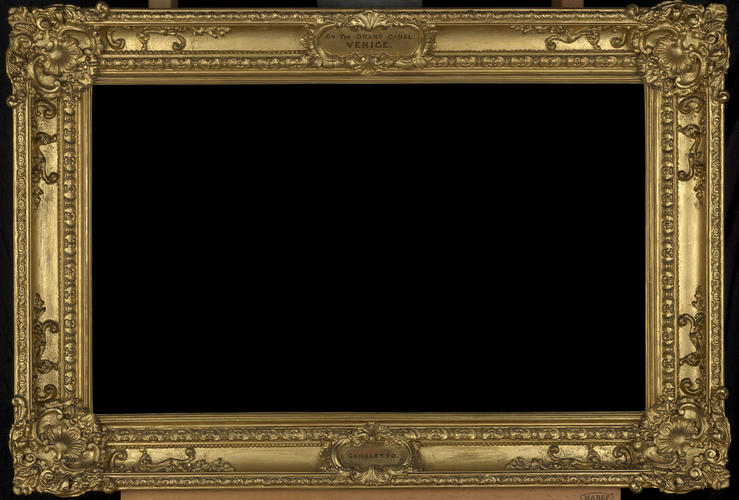-
1 of 253523 objects
Frame for RCIN 400523, Canaletto, Venice: The Grand Canal from the Carità towards the Bacino 18th-century with 19th-century additions
Carved and giltwood with composition additions | 67.1 x 98.9 x 8.8 cm (frame, external) | RCIN 7400523

Masters of the Consul Smith picture frames (mid 18th century)
Frame for RCIN 400523, Canaletto, Venice: The Grand Canal from the Carita towards the Bacino 18th-century with 19th-century additions
-
A remarkable number of paintings acquired by George III in 1762 from the collection of Consul Joseph Smith, have remained in the original Venetian frames chosen by Smith himself. The majority of Smith’s frames are of a Venetian ‘panel’ type, characterised by an elegant rococo moulding of carved leaf, flower and ‘C’ scroll ornament, with plain panels (from which the name derives) in the centres. However, a different pattern was chosen by Smith for his series of paintings of the Grand Canal. This pattern appears to be unique to Consul Smith. It consists of a narrow rococo moulding with carved ornament of repeating ‘C’-scrolls, acanthus leaves to corners and a small rope twist on the back edge. Other almost identical frames survive around paintings by Canaletto supplied by Smith to English clients – for example the twenty-two views of the Grand Canal, made for John, 4th Duke of Bedford, now at Woburn. They are also to be seen around the series of nineteen reduced versions in grisaille, of allegorical tombs of illustrious Englishmen, commissioned by the Irish impresario and art dealer Owen Swiny (McSwiny) when he was in Venice.
All the frames of this type in the Royal Collection were extended with composition additions in the 1820s. Composition is a mixture of whiting (chalk), glue, resin and linseed oil which can be pressed to make moulded ornament; first developed in London in the late eighteenth century, it allowed a variety of ornament to be created more swiftly and cheaply than carved decoration. In 1828 George IV moved a number of Smith’s pictures (notably works by Canaletto and Zuccarelli) to Windsor Castle and their frames were enriched and enlarged by Joseph Crouzet in order to be incorporated into Jeffry Wyatville’s new decorative scheme for the Grand Corridor there. The additions were in the Empire-style – consisting of an extending scoop, or hollow and extravagant scrolling cartouche corners, and knull (or top edge) with a fillet of flower-head and twisted ribbon ornament.
The effect of the aggrandisement can be seen in a watercolour view of the Grand Corridor, by Joseph Nash (1848, RCIN 817132.n). The slight, elegant frames that Consul Smith originally chose for his paintings must have appeared too insubstantial in the Corridor, where they competed with Lawrence frames and imposing French furniture. -
Creator(s)
(framemaker) -
Medium and techniques
Carved and giltwood with composition additions
Measurements
67.1 x 98.9 x 8.8 cm (frame, external)
Category
Object type(s)